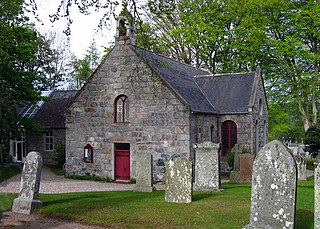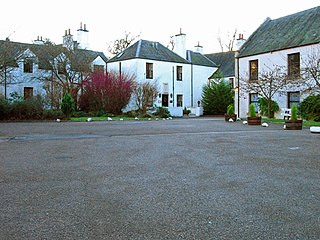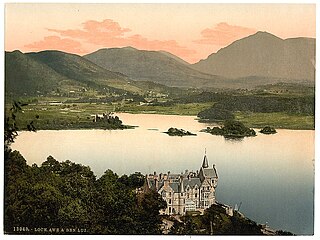
Kirkton of Durris is a hamlet in the Kincardine and Mearns area of Aberdeenshire, Scotland. [1]

Kirkton of Durris is a hamlet in the Kincardine and Mearns area of Aberdeenshire, Scotland. [1]
Historic structures in the vicinity include Maryculter House, Durris House and Muchalls Castle.
A short history of the parish of Durris was written in 2019: The Parish of Durris: some historical sketches. 239pp. ISBN 978-1-5272-3732-2. The author was Robin Jackson.
The book contains the following chapters: 1. Early history; 2. Religious history of Durris; 3. Statistical accounts; 4. Life in a rural parish: Part one; 5. Life in a rural parish: Part two; 6. A Durris kirk mystery; 7. Durris House; 8. Lairds and proprietors of Durris; 9. The Milne family of Durris; 10. Conclusion.
57°3′22″N2°22′29″W / 57.05611°N 2.37472°W

Kincardineshire or the County of Kincardine, also known as the Mearns, is a historic county, registration county and lieutenancy area on the coast of north-east Scotland. It is bounded by Aberdeenshire on the north, and by Angus on the south-west.

Kincardine and Mearns is one of six area committees of the Aberdeenshire council area in Scotland. It has a population of 38,506. There are significant natural features in this district including rivers, forests, mountains and bogs.

Maryculter or Kirkton of Maryculter is a village in the Lower Deeside area of Aberdeenshire, Scotland. The River Dee separates it from the town of Peterculter, and the B979 road runs through Maryculter. Maryculter House Hotel lies slightly north of the village along the south bank of the River Dee and to the west of Templars Park. The Old Mill Inn, a former coaching inn dating back to the 18th century lay at the mouth of the Crynoch Burn from 1797 until its demolition in February 2021 after being damaged by an extensive fire. At the edge of the village of Maryculter is a public forest land, known as the Oldman Wood, through which flows the Crynoch Burn. Also the children's theme park, StoryBook Glen, which also consists of a shop and restaurant is located near the old church which is still in use today as a Church of Scotland. Other notable vicinity buildings include the former Lairhillock Inn which closed in March 2020 and Muchalls Castle. Maryculter also has an animal sanctuary, Blaikiewell Animal Sanctuary.

Skene Parish Church is a congregation of the Church of Scotland in Skene, part of the Presbytery of Gordon. The parish has two places of worship, Skene Church in Kirkton of Skene and Trinity Church in Westhill. The current minister is Rev. Stella Campbell.

Auchterless is a village in Aberdeenshire, Scotland; grid reference NJ 713 416, postcode AB53 8BG. The nearest large settlement is Turriff. It is traditionally known as "Kirkton of Auchterless".

Menmuir is a parish in the county of Angus in Scotland.

Maryculter House is a historic house in the village of Maryculter, or Kirkton of Maryculter, in the Lower Deeside area of Aberdeenshire, Scotland.

Durris Forest is a chiefly coniferous forest south of the River Dee approximately three kilometres west of Netherley in Aberdeenshire, Scotland. The A957 road forms the southwest boundary of Durris Forest, separating it from Fetteresso Forest. The Durris Forest includes several smaller named woodlands. The ancient route of Elsick Mounth crosses the Grampian Mounth within the Durris Forest. Notable natural features in the vicinity include Red Moss and Meikle Carewe Hill. Notable historic features in this area include Raedykes Roman Camp, Muchalls Castle and Maryculter House.
The Dunecht Estate is one of the largest private estates in Aberdeenshire, Scotland at 53,000 acres (210 km2). It is owned by The Hon Charles Anthony Pearson, the younger son of the 3rd Viscount Cowdray. Dunecht's business interests include farming, forestry, field sports, minerals, let houses, commercial lets and tourism.

Inishail is an island and former parish, in Loch Awe, Scotland.

Fordyce is a village in Aberdeenshire, Scotland that is slightly inland from the point where the Burn of Fordyce meets the sea between Cullen and Portsoy. It has existed since at least the 13th century. In 1990, Charles McKean wrote that Fordyce was "a sheer delight to discover, concealed as it is from the passing eye by hills and rolling countryside".

Kirkton of Tough, usually shortened to Tough, is a settlement in the Marr area of Aberdeenshire, Scotland at grid reference NJ615129. It is about 4 kilometres southeast of Alford and 143 km (89 mi) from Edinburgh. Tough is where the Aberdeen Angus breed of cattle was first bred.

Balfour, Aberdeenshire is a settlement on Royal Deeside in Aberdeenshire, Scotland. Balfour lies south of the River Dee.
Lower Deeside is a region along the River Dee in Aberdeenshire and Aberdeen in Scotland. The boundaries of this area are subject to interpretation, since the usage has altered through historic times; however, the area is generally associated with the communities of Durris, Maryculter and Banchory-Devenick in the historic district of Kincardineshire and the communities of Peterculter, Milltimber, Bieldside and Cults in Aberdeen.

Kirkton is a small area in the north-west of Livingston in West Lothian, Scotland. The area is mainly occupied by an industrial estate, as well as by some residential housing areas. The Killandean burn, a small stream runs through the area.

Kirkton is a village in the Scottish Borders area of Scotland, off the A6088, near Hawick. Grid Ref. NT5413.

St Mary's College, Blairs, situated near Aberdeen in Scotland, was from 1829 to 1986 a junior seminary for boys and young men studying for the Roman Catholic priesthood. Part of the former college now houses Blairs Museum, the museum of Scotland's Catholic heritage. The New Chapel is a Category A listed building, with the other buildings listed as Category B.

Kirkton is a small village between Duncow and Dumfries in Dumfries and Galloway, Scotland. It is located near the River Nith and has a Grade B listed church.

Kirkmahoe is a civil parish in Dumfries and Galloway. The parish contains the settlements Kirkton, where the parish church is located, Dalswinton and Duncow. It is bounded by the parishes of Dumfries to the south, Holywood and Dunscore to the west, and Kirkmichael and Tinwald to the east.
Tower of Deskford was a 14th-century tower house, about 3.5 miles (5.6 km) south of Cullen, Moray, Scotland at Deskford, west of the burn. The tower and its associated buildings are a Scheduled Ancient Monument.